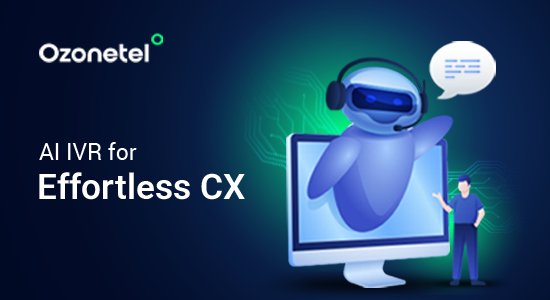- Resources
- What is an Omnichannel Contact Center?
What is an Omnichannel Contact Center?

As a part of the customer service industry, you’re likely no stranger to the frustration of juggling multiple channels and platforms. You’ve probably found yourself switching between phone calls, chatbots, and email, only to find that each channel has unique challenges and limitations. You’re not alone in this struggle.
In fact, a recent study found that 80% of customers expect a consistent experience across all these channels. And to meet this growing demand, you need a more comprehensive approach that seamlessly integrates multiple channels and platforms. That’s where an omnichannel contact center comes in. The software integrates multiple channels, empowering you to deliver exceptional customer service and enhance satisfaction.
In fact, according to a study, companies that adopt omnichannel strategies see a 91% increase in customer retention. So what are you waiting for? Keep reading to get a better understanding of what omnichannel contact center solutions are and how you can implement them in your business.
In this article, we will explore:
- 1. What is Omnichannel Contact Center?
- 2. Omnichannel Contact Software Meaning
- 3. Understanding the Need for Omnichannel Contact Centers and Why They Matter
- 4. Features of Omnichannel Contact Center
- 5. Benefits of Omnichannel Contact Center
- 6. Omnichannel Vs. Multichannel
- 7. Best Omnichannel Contact Center Practices and Strategies
What is Omnichannel Contact Center?
An omnichannel contact center is a customer service operation providing a seamless and consistent customer experience across multiple communication channels. It goes beyond traditional call centers by integrating various touchpoints, such as voice calls, email, chat, and social media into a unified platform.
This approach ensures that customers can connect with a company through their preferred channel without repeating information or restarting their inquiry. Moreover, in an omnichannel contact center, customer interactions are routed intelligently based on factors like skillset, language, and availability. This ensures that the most appropriate agent handles inquiries.
Omnichannel Contact Software Meaning
Omnichannel contact software is the software or technology platform enabling businesses to interact with customers across multiple communication channels, helping deliver exceptional customer experiences across multiple touchpoints.
This cutting-edge technology seamlessly integrates various communication channels into a unified platform, including voice, chat, email, text, and social media. Doing so empowers customer service agents to connect with customers through their choice of channel while maintaining a comprehensive view of their journey and previous interactions.
Moreover, omnichannel contact center software leverages advanced features such as intelligent routing, workforce management, and real-time analytics, helping businesses optimize their operations and ensure efficient resource allocation. By integrating with other systems like customer relationship management (CRM) and enterprise resource planning (ERP), these solutions provide agents with a comprehensive view of customer data, empowering them to deliver tailored, informed, and contextual support.
Understanding the Need for Omnichannel Contact Centers and Why They Matter
As customer expectations continue to change, businesses are recognizing the importance of implementing omnichannel contact centers to meet the demands of today’s digitally-involved consumers. By providing a unified and consistent experience across various touchpoints, omnichannel contact centers are in high demand, addressing critical challenges and driving superior customer satisfaction.
Here are a few more points that drive the importance of omnichannel contact centers:
Channel Fragmentation
Traditional contact centers often operate in silos, with separate teams handling different communication channels like voice, email, chat, and social media. This fragmented approach can lead to disjointed customer experiences and inefficiencies. Omnichannel contact centers eliminate these silos by integrating all channels into a single, unified platform, ensuring seamless transitions and consistent service across touchpoints.
Disjointed Customer Journeys
Customers expect a continuous and personalized experience, irrespective of the channel they use to interact with your business. Omnichannel contact centers provide agents with a comprehensive view of the customer’s journey, allowing them to pick up conversations seamlessly and deliver tailored support based on previous interactions and context.
Inefficient Resource Allocation
With multiple channels operating independently, allocating resources effectively and ensuring optimal agent utilization becomes challenging. Omnichannel contact centers leverage intelligent routing and workforce management tools, enabling efficient distribution of inquiries across channels and ensuring that the right agent with the appropriate skills is assigned to handle each customer interaction.
Limited Scalability
As customer demands evolve and new communication channels emerge, traditional contact centers struggle to adapt quickly. Omnichannel contact centers offer the flexibility and scalability to seamlessly integrate new channels. This ensures that your business remains competitive and responsive to changing customer preferences.
Features of Omnichannel Contact Center
Omnichannel contact centers integrate multiple communication channels into a unified platform. This empowers you to engage with customers through their preferred touchpoints while providing a seamless and consistent journey. Moreover, integration with CRM systems offers a more comprehensive view of the customer data, facilitating personalized interactions. Some more features of an omnichannel contact center are:

Advanced ACD System
An advanced Automatic Call Distribution (ACD) system ensures that incoming calls are routed to available agents in the shortest possible time, delighting customers with fast responses and increasing operational efficiency. Furthermore, the ability to identify premium customers based on their calling numbers and connect them within three rings demonstrates your commitment to prioritizing high-value customers and delivering exceptional service.
Reporting and Analytics
Comprehensive reporting and analytics features offer valuable insights into your contact center’s performance. With intuitive visualizations and easy-to-consume data presentations, you can spot call trends, identify volume patterns, and ideate remedial measures to maintain outstanding customer experiences. Additionally, the ability to detect anomalies in the data empowers you to make informed improvements to your processes, ensuring continuous optimization.
Workforce Management
Effective workforce management is crucial for optimizing your contact center’s performance. A live dashboard allows you to manage your call center operations efficiently, analyze performance metrics, and implement best practices for call center management. Real-time supervision of phone teams ensures the quality of conversations and enables you to optimize operations seamlessly.
Streamlined Routing
Omnichannel Routing allows you to set rules for routing customer inquiries to the right agents. For example, if a customer sends a chat about a specific product, it can be automatically routed to the relevant product team’s agent. The agent can respond within their dashboard without switching applications.
Routing options include skill-based, round-robin, most idle agents, and more. Automated messages can acknowledge receipt, provide self-help guides, and estimate wait times. Chatbots can also respond to queries. The IVR system can route callers to the appropriate agent or enable self-service via chatbots for phone calls.
The key benefit is ensuring inquiries efficiently reach the right skilled agent across all channels from a unified agent dashboard.
Mobile App Integration
With mobile app integration, your agents can enjoy the convenience of managing customer interactions on the go. Features such as making and receiving calls, creating and transferring notes, accessing call logs, and reviewing call summaries empower your agents to collaborate seamlessly with teammates, fostering a collaborative and efficient work environment and ultimately contributing to creating remarkable customer experiences.
Easy Integrations
According to reports, 53% of customers reported that their contacts with customer support staff were fragmented. This statistic underscores the necessity of integrated communication in creating a more seamless and holistic customer journey. An omnichannel system unifies all communication channels, allowing customers to switch between them smoothly without losing context.
Benefits of Omnichannel Contact Center
Customer support processes become more efficient when linked together in an omnichannel ecosystem. It streamlines the process of using client data and digital tools. For example, automated routing, powered by unified data insights, swiftly routes consumers to appropriate agents, increasing efficiency. Let’s explore a few more benefits of an omnichannel contact center in detail:
Agile Channel Activation and Lowered Support Costs
Businesses that have already established an omnichannel customer experience ecosystem gain a distinct competitive edge in swiftly designing and launching new channels. With a well-established omnichannel system in place, introducing additional channels becomes a seamless process, reducing the need to start from scratch each time.
Moreover, companies leveraging omnichannel solutions have reported slashing support costs by up to 30% and improving customer satisfaction by 19%. You can reduce your dependency on traditional call support by enabling effective call deflection and optimizing operational costs.
Improved Customer Experience, Loyalty, and Trust
Omnichannel customer service fosters speed, convenience, transparency, and trust in customer interactions. By enabling seamless transitions between channels, you showcase your organization’s commitment to buyers and ensure a smoother journey for them.
This unified experience across touchpoints increases customer satisfaction, cultivates loyalty, and reinforces trust in your brand. When consistently delivering exceptional digital customer experiences over time, you forge deeper connections with your audience, setting the foundation for long-lasting relationships.
Personalized Experiences
Omnichannel personalization technology harnesses consumer insights to create highly personalized experiences, boosting customer engagement and brand loyalty. This approach transcends the limitations of a one-size-fits-all strategy, making customers feel valued and understood.
As a result, it amplifies customer engagement, forging a deeper connection between your brand and its audience. These personalized interactions foster a sense of loyalty, as customers appreciate the extra effort taken to cater to their preferences and needs.
Value from Customer Data and Connectivity
Omnichannel customer service extends beyond meeting customers at different buying stages; it empowers you to anticipate and proactively address their evolving needs. With connected devices and customer data at your disposal, you can develop services that proactively address customer requirements before they even arise. Understanding and fulfilling customer needs before they become pain points boost customer retention and cultivate enduring customer relationships that drive long-term success.
Omnichannel Vs. Multichannel
The approaches of omnichannel and multichannel contact centers stand apart in terms of their integration, customer experience, context management, user interface, real-time insights, and ticket handling. While both aim to serve customers across multiple channels, they do so with distinct strategies and outcomes. The following table outlines the key differences between omnichannel and multichannel contact centers:| Criteria | Omnichannel Contact Center | Multichannel Contact Center |
|---|---|---|
| Channel Integration | Integrated into a unified platform | Channels function independently without integration |
| Customer Experience | Consistent experience across all support channels | Varying experiences on each channel due to lack of integration |
| Customer Context | Context maintained across channels | Limited or no transfer of context between channels |
| User Interface | All channels operate within a single interface/platform | Each channel requires its own interface/platform to manage |
| Real-time Insights | Insights available in real-time across channels | Only historical reporting available, no real-time insights |
| Ticket Handling | Single team can manage requests across all channels | Separate teams required for managing requests on each channel |
Best Omnichannel Contact Center Practices and Strategies
Adopting an omnichannel contact center strategy requires a well-defined vision and a customer-centric approach. One that embraces best practices spanning across people, processes, and technology. Also, by aligning your strategies with industry-leading practices, you can deliver personalized and seamless experiences that foster customer loyalty and drive business growth.

How Can Implementing Omnichannel Contact Software Improve Overall CX
The omnichannel contact center solution seamlessly integrates multiple communication channels, enabling your customers to engage with your company through their preferred medium: voice calls, chats, emails, social media, or messaging apps like WhatsApp. By consolidating these interactions into a unified platform, you eliminate the need for customers to repeat their information across different touchpoints, fostering a seamless and consistent experience.
Transforming BigBasket’s Customer Service
Online grocery firm BigBasket prioritizes quick and efficient customer service. With Ozonetel contact center solutions, they answer over 95% of calls within 10 seconds and have been able to reduce Average Handle Time from 5 to 3.5 minutes. According to BigBasket co-founder Vipul Parekh, partners like Ozonetel have been instrumental. They’ve provided the necessary technological infrastructure and customized it to seamlessly align with our customers’ needs and preferences.
Optimizing Operational Efficiency for a Stockbroking Company
One of India’s top stockbroking companies used Ozonetel’s robust CX platform to handle 40,000+ calls daily and 1000+ calls concurrently. With a self-service IVR, they further automated 40% of all incoming calls, reducing the need for agent intervention. Supervisors used Ozonetel’s Call Monitoring Dashboard, Darwinbox integration, and Rogue Agent features to ensure high productivity and discipline. As a result, their Average Handle Time reduced by 25%, achieved FCR of 80% and boosted CSAT by 60%.
Enhancing Customer Service and Sales Automation for an NBFC
A leading NBFC enhanced customer service responsiveness and automated sales calls using Ozonetel’s CX solution. They leveraged our Self-service IVR to automate 50% of their inbound queries including requests for statements of accounts, welcome letters, and payment rescheduling. Upon service request through the IVR, customers receive WhatsApp notifications. Post-call wrap-up reduced by 75% to 32 seconds. Lead calling automation via CRM-dialer integration ensures instant response, achieving a 5X efficiency increase and tripling conversion rates to 10%.
Ensuring Effortless Communication for an Insurance Company
A leading insurance company wanted to make communication experiences around policies, claims, and renewals reassuring and effortless for their customers. They used Ozonetel self-service IVR to automate a wide range of requests — policy endorsements, changes, renewals, and more — quickly and without any agent intervention. They also deployed advanced routing based on the predictive engine which helped in directing queries to the right skill group. The solution led to 20% less time spent in IVR, 20% higher routing accuracy, and 50% faster resolutions — all contributing to a CSAT of 90%.
Conclusion
Embracing an omnichannel contact center strategy is no longer an option but a necessity for organizations that aspire to deliver exceptional customer experiences and foster long-lasting relationships with their customers. By integrating multiple communication channels into a unified platform, an omnichannel contact center empowers businesses to engage with customers through their preferred touchpoints, providing a seamless and consistent journey that builds trust and loyalty.
You can also go one step ahead and invest in digital solutions such as Ozonetel, which offers omnichannel features. Ozonetel’s CX hub provides omnichannel routing capabilities, allowing businesses to seamlessly manage customer interactions across multiple channels such as voice calls, chat, email, and more. Intelligent routing rules automatically direct interactions to the most appropriate agent or department based on skill set, availability, and language preference.
Want to see what Ozonetel can do for your company? Sign up today for a free 7-day trial.
Frequently Asked Questions
Voice bots are advanced tools that enable communication with users through spoken language. They make it easy to interact naturally with apps, devices, and platforms, understanding and responding to spoken commands. AI voice chatbots comprehend user requests through a combination of key components: Automatic Speech Recognition (ASR), Natural Language Understanding (NLU), Text-to-Speech (TTS), and Conversation Module.
Conversational IVR refers to an interactive voice response system that allows customers to interact with a computerized voice using spoken language. On the other hand, a voice bot is an AI-powered technology that uses natural language processing to comprehend and respond to voice commands. While conversational IVR is typically used for phone-based interactions, Voicebots can operate across various devices and platforms, including smart speakers, smartphones, and IoT devices.
The primary difference between a voice bot and a chatbot lies in the medium of interaction. A voice bot interacts with users through spoken language, utilizing speech recognition and natural language understanding technologies to process voice commands or queries. Conversely, a chatbot interacts with users via text-based communication, typically through messaging platforms, websites, or mobile apps.
Prashanth Kancherla
Chief Operating Officer, Ozonetel Communications
Over the past decade, Prashanth has worked with 3000+ customer experience and contact center leaders...
Chief Operating Officer, Ozonetel Communications
Over the past decade, Prashanth has worked with 3000+ customer experience and contact center leaders to comprehensively understand the need for effective and efficient customer communications at every step of their journey with a brand. Deeply embedded in today’s CCaaS ecosystem, he has been instrumental in Ozonetel's growth and contributed in various roles including product management, sales, and solution architecture.







